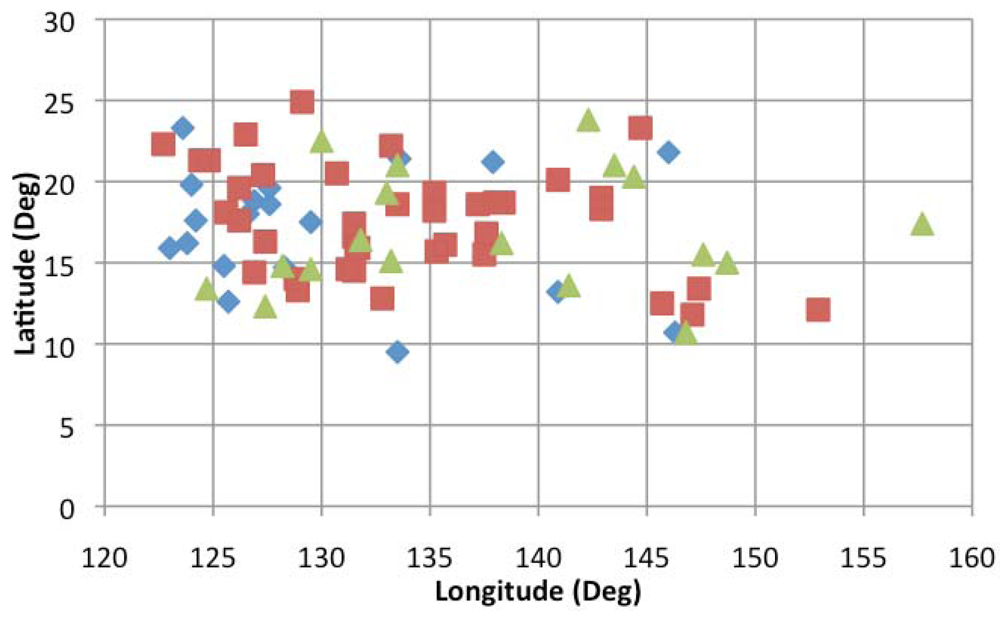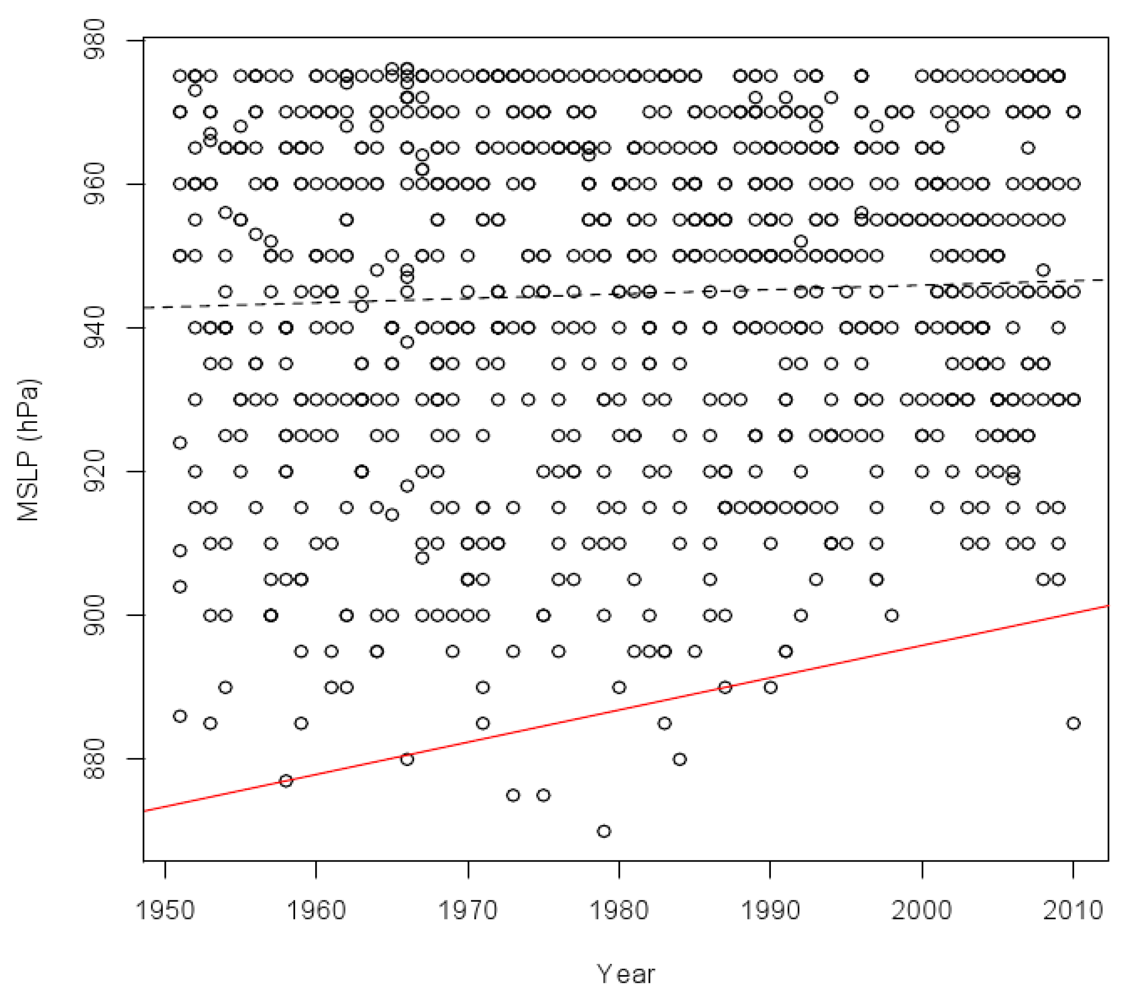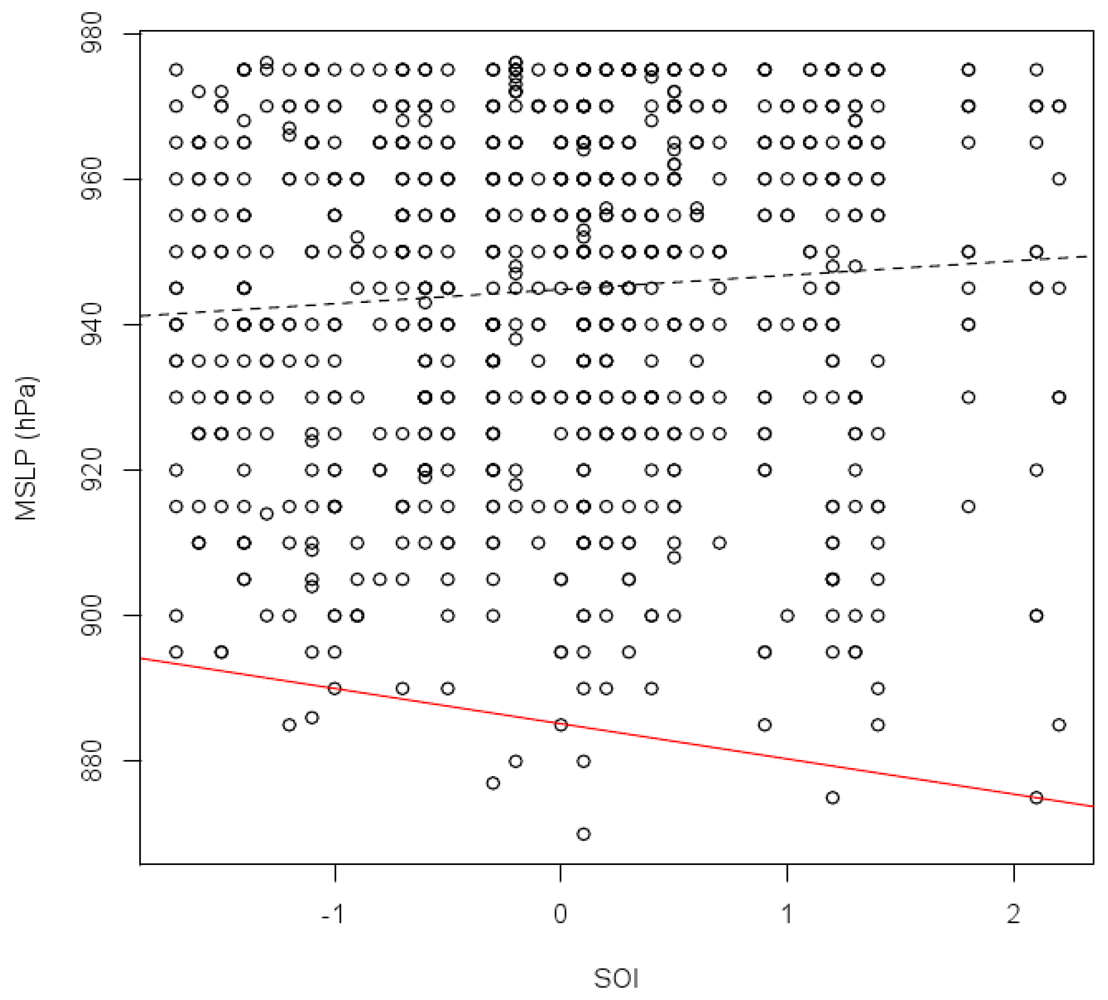Trends in Intense Typhoon Minimum Sea Level Pressure
Abstract
:1. Introduction
2. Data and Analysis Methods


3. Results

| Statistic | Quantile | ||||
|---|---|---|---|---|---|
| 0.15 | 0.10 | 0.05 | 0.025 | 0.01 | |
| Trend (hPa/year) | 0.30 | 0.35 | 0.33 | 0.36 | 0.45 |
| Standard Error (hPa/year) | 0.09 | 0.07 | 0.10 | 0.10 | 0.22 |
| Probability of null | 0.00 | 0.00 | 0.00 | 0.00 | 0.03 |
| Statistic | Quantile | ||||
|---|---|---|---|---|---|
| 0.15 | 0.10 | 0.05 | 0.025 | 0.01 | |
| Trend (hPa/year) | 0.15 | 0.00 | −0.17 | 0.00 | −0.16 |
| Standard Error (hPa/year) | 0.20 | 0.15 | 0.18 | 0.32 | 0.29 |
| Probability of null | 0.46 | 1.00 | 0.34 | 1.00 | 0.57 |
| Statistic | Quantile | ||||
|---|---|---|---|---|---|
| 0.15 | 0.10 | 0.05 | 0.025 | 0.01 | |
| Trend (hPa/year) | 0.30 | 0.00 | 0.00 | 0.45 | 0.56 |
| Standard Error (hPa/year) | 0.26 | 0.25 | 0.40 | 0.65 | 0.45 |
| Probability of null | 0.26 | 1.00 | 1.00 | 0.46 | 0.31 |

| Statistic | Quantile | ||||
|---|---|---|---|---|---|
| 0.15 | 0.10 | 0.05 | 0.025 | 0.01 | |
| Trend (hPa) | 0.00 | 0.00 | 0.00 | −2.00 | −4.84 |
| Standard Error (hPa) | 1.90 | 1.82 | 1.67 | 2.29 | 2.79 |
| Probability of null | 1.00 | 1.00 | 1.00 | 0.40 | 0.08 |
4. Conclusions
- Application of quantile regression to the WMO best track data used here indicates a decrease in the intensity (increase in lifetime MSLP) with time.
- A likely source of the decrease is the change in measurement of MSLP with the cessation of routine aircraft reconnaissance in 1987. There is no significant trend in intense storms either before or after 1987 when the two periods are analyzed separately.
- While El Nino conditions (negative SOI) are associated with lower average MSLP (greater intensity), in agreement with previous findings, we found no significant dependence of MSLP on SOI for the most intense quantiles considered here, regardless of whether pressures based on [21,22] and JTWC are used.
Acknowledgements
References
- Webster, P.W.; Holland, G.J.; Curry, J.A.; Chang, H.-R. Changes in tropical cyclone number, duration, and intensity in a warming environment. Science 2005, 309, 1844–1846. [Google Scholar] [CrossRef]
- Wu, M.C.; Yeung, K.H.; Chang, W.L. Trends in western North Pacific tropical cyclone intensity. EOS 2006, 87. [Google Scholar]
- Maue, R.N. Recent historically low global tropical cyclone activity. Geophys. Res. Lett. 2011, 38. [Google Scholar]
- Landsea, C.W.; Harper, B.A.; Hoarau, K.; Knaff, J.A. Can we detect trends in extreme tropical cyclones? Science 2006, 313, 452–454. [Google Scholar]
- Kossin, J.P.; Knapp, K.R.; Vimont, D.J.; Murnane, R.J.; Harper, B.A. A globally consistent reanalysis of hurricane variability and trends. Geophys. Res. Lett. 2007, 34. [Google Scholar]
- Song, J.-J.; Wang, Y.; Wu, L. Trend discrepancies among three best track data sets of western North Pacific tropical cyclones. J. Geophys. Res. 2010, 115. [Google Scholar]
- Knaff, J.A.; Sampson, C.R. Reanalysis of West Pacific Tropical Cyclone Maximum Intensity 1966–1987. In Proceedings of the 27th Conference on Hurricanes Tropical Meteorology, Monterey, CA, USA, 24–28 April 2006; p. 5B.5.
- Knapp, K.R.; Kruk, M.C.; Levinson, D.H.; Diamond, H.J.; Neumann, C.J. The international best track archive for climate stewardship (IBTrACS). Bull. Am. Met. Soc. 2010, 91, 363–376. [Google Scholar] [CrossRef]
- Bouchard, R.H. A Climatology of Very Intense Typhoons: Or Where Have All the Super Typhoons Gone?; Annual Tropical Cyclone Report; Joint Typhoon Warning Center: Pearl Harbor, HI, USA, 1990; pp. 266–269. [Google Scholar]
- Elsner, J.B.; Liu, K. Examining the ENSO-typhoon hypothesis. Clim. Res. 2003, 25, 43–54. [Google Scholar] [CrossRef]
- Chan, J.C.L. Decadal variations of intense typhoon occurrence in the western North Pacific. Proc. R. Soc. A 2008, 464, 249–272. [Google Scholar] [CrossRef]
- Camargo, S.J.; Robertson, A.W.; Gaffney, S.J.; Smyth, P.; Ghil, M. Cluster analysis of typhoon tracks. Part II: Large-scale circulation and ENSO. J. Clim. 2007, 20, 3654–3676. [Google Scholar] [CrossRef]
- Zhan, R.; Wang, Y.; Lei, X. Contributions of ENSO and East Indian Ocean SSTA to the interannual variability of Northwest Pacific tropical cyclone frequency. J. Clim. 2011, 24, 509–521. [Google Scholar]
- Koenker, R.; Hallock, K.F. Quantile regression. J. Econ. Perspect. 2001, 15, 143–156. [Google Scholar] [CrossRef]
- Jagger, T.H.; Elsner, J.B. Modeling tropical cyclone intensity with quantile regression. Int. J. Climatol. 2009, 29, 1351–1361. [Google Scholar] [CrossRef]
- Elsner, J.B.; Kossin, J.P.; Jagger, T.H. The increasing intensity of the strongest tropical cyclones. Nature 2008, 455, 92–95. [Google Scholar]
- Dvorak, V. Tropical Cyclone Intensity Analysis Using Satellite Data; NOAA Technical Report No. 11; National Oceanic and Atmospheric Administration: Suitland, MD, USA, 1984. [Google Scholar]
- Lin, I.-I.; Black, P.G. Ocean’s Impact on the Intensity of Three Recent Typhoons (Fanapi, Malakas, and Megi)—Results from the ITOP Field Experiment. In Proceedings of the 65th Interdepartmental Hurricane Conference, Miami, FL, USA, 28 February–3 March 2011; 2011; p. P08. [Google Scholar]
- Yeh, S.-W.; Kang, S.-K.; Kirtman, B.P.; Kim, J.-H.; Kwon, M.-H.; Kim, C.-H. Decadal change in relationship between western North Pacific tropical cyclone frequency and the tropical Pacific SST. Meteorol. Atmos. Phys. 2010, 106, 179–189. [Google Scholar]
- Zhao, X.; Chu, P.-S. Bayesian changepoint analysis for extreme events (typhoons, heavy rainfall, and heat waves): An RJMCMC approach. J. Clim. 2010, 23, 1034–1046. [Google Scholar] [CrossRef]
- Hoarau, K.; Padgett, G.; Hoarau, J.-P. Have There been Any Typhoons Stronger than Super Typhoon Tip? In Proceedings of the 26th Conference on Hurricanes and Tropical Meteorology, San Diego, CA, USA, 29 April–3 May 2004; p. 16C.1.
- Hoarau, K.; Chalonge, L.; Hoarau, J.-P. The Reasons for a Reanalysis of the Typhoons Intensity in the Western North Pacific. In Proceedings of the 27th Conference on Hurricanes and Tropical Meteorology, Monterey, CA, USA, 24–28 April 2006; p. 5B.2.
© 2012 by the authors; licensee MDPI, Basel, Switzerland. This article is an open-access article distributed under the terms and conditions of the Creative Commons Attribution license (http://creativecommons.org/licenses/by/3.0/).
Share and Cite
Durden, S.L. Trends in Intense Typhoon Minimum Sea Level Pressure. Atmosphere 2012, 3, 124-131. https://doi.org/10.3390/atmos3010124
Durden SL. Trends in Intense Typhoon Minimum Sea Level Pressure. Atmosphere. 2012; 3(1):124-131. https://doi.org/10.3390/atmos3010124
Chicago/Turabian StyleDurden, Stephen L. 2012. "Trends in Intense Typhoon Minimum Sea Level Pressure" Atmosphere 3, no. 1: 124-131. https://doi.org/10.3390/atmos3010124
APA StyleDurden, S. L. (2012). Trends in Intense Typhoon Minimum Sea Level Pressure. Atmosphere, 3(1), 124-131. https://doi.org/10.3390/atmos3010124




